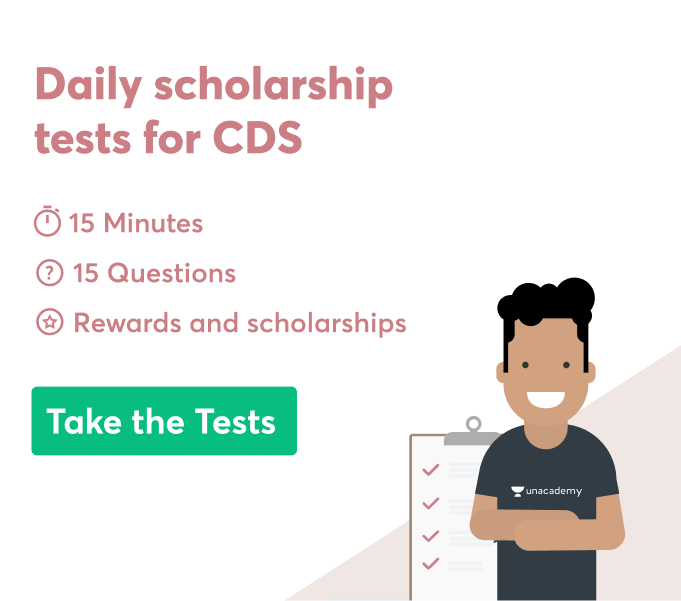CDS syllabus 2022 has been released by the UPSC (Union Public Service Commission) along with the notification. CDS syllabus will be released along with the information on their official website i.e upsc.gov.in. The exam is conducted to recruit candidates for the Indian Naval Academy (INA), Indian Military Academy (IMA), Air Force Academy (AFA) and Officer Training Academy (OTA). The candidates must go through the UPSC CDS 2022 syllabus to determine which includes the important topics and chapters. Once the candidates get through the CDS syllabus 2022 along with the exam pattern, they will be able to save time by creating a proper timetable. Get more details for CDS Syllabus 2022 here along with the subjects, chapters, marking scheme, etc.
Overview of CDS Syllabus 2022
Checks the below-provided CDS syllabus for 2022 –
Parameters | Details |
Exam Mode | Offline |
Exam Stages | Written exam and SSB Interview |
Number of sections in exa | 3 sections for IMA, INA, and Air Force Academy. Two sections for OTA (Officers Training Academy) |
CDS Exam Subjects | English, General Knowledge, and Elementary Mathematics |
Nature of questions | Objective-type |
Question Level | The standard of questions in Mathematics is of Class 10 standard and other subjects is of Graduation level |
Duration of test | Two hours for each subject |
Language of question paper | English and Hindi |
CDS Exam Scheme 2022
The CDS exam comprises: Written Examination and Interview
The subjects of the written examination for admission to the Indian Military Academy (IMA), Indian Naval Academy (INA) and Air Force Academy (AFA) include:
English – 100 marks paper of total 2 hours duration
General Knowledge – 100 marks paper of total 2 hours duration
Elementary Mathematics – 100 marks paper of total 2 hours duration
The subjects of the written examination for admission to Officers’ Training Academy (OTA) include:
English – 100 marks paper of total 2 hours duration
General Knowledge – 100 marks paper of total 2 hours duration
The papers in all subjects will have objective type questions. The papers of General Knowledge and Elementary Mathematics will be set in Hindi as well as English.
English
The purpose of the English question paper is to test the candidates’ understanding of the English language as well as their ability to use words effectively.
General Knowledge
The General Knowledge question paper is designed to test candidates’ knowledge of current affairs and matters of everyday observations and experience. The General Knowledge question paper will also include questions on Geography and Indian History.
Elementary Mathematics
Arithmetic
Number System — Rational and Real numbers, Natural numbers, and Integers. Fundamental operations, addition, decimal fractions, multiplication, subtraction, division, square roots. Time and distance, unitary method, profit and loss, time and work, percentages, applications to simple and compound interest, variation, ratio and proportion.
Elementary Number Theory — Division algorithm. Prime and composite numbers. Factorisation Theorem. Tests of divisibility by 2, 3, 4, 5, 9 and 11. Multiples and factors. Euclidean algorithm. H.C.F. and L.C.M. Logarithms to base 10, use of logarithmic tables, laws of logarithms.
Algebra
Basic Operations, Remainder Theorem, simple factors, Theory of polynomials, relation between its roots and coefficients (Only real roots to be considered), H.C.F., L.C.M., solutions of quadratic equations.
Simultaneous linear inequalities in two variables and their solutions.
Practical problems involving two simultaneous linear equations or inequalities in two variables or quadratic equations in one variable & their solutions.
Simultaneous linear equations in two unknowns — graphical and analytical solutions.
Set language and set notation, Laws of indices, Rational expressions and conditional identities.
Trigonometry
Sine ×, cosine ×, Tangent × when 0° < × < 90° Values of sin ×, cos × and tan ×, for × = 0°, 30°, 45°, 60° and 90°
Simple cases of heights and distances.
Simple trigonometric identities.
Use of trigonometric tables
Geometry
Lines and angles.
Plane and plane figures.
Theorems on:
(i) Parallel lines
(ii) Properties of angles at a point
(iii) Congruence of triangles
(iv) Sides and angles of a triangle
(v) Circles and its properties including tangents and normal
(vi) Loci
(vii) Properties of angles, sides and diagonals of a parallelogram, rectangle and square
(viii) Similar triangles
(ix) Concurrence of medians and altitudes
Mensuration
Areas of square, triangle, circle, rectangle, and parallelogram.
Areas of figures that can be split up into these figures (Field Book).
Surface area and volume of spheres.
Lateral surface and volume of right circular cones and cylinders.
Surface area and volume of cuboids.
Statistics
Collection and tabulation of statistical data.
Graphical representation frequency polygons, bar charts, pie charts, histograms, etc.
Measures of central tendency.
Intelligence and Personality Test
The SSB interview procedure is divided into two-stages – Stage I and Stage II.
Only candidates who pass stage I will be permitted to appear for stage II.
- a) Stage I – Officer Intelligence Rating (OIR) test and Picture Perception & Description Test (PPDT).
The candidates will be shortlisted based on their performance in both the OIR Test and PPDT.
- b) Stage II – Interview, Group Testing Officer tasks, Psychology Tests and the Conference.
A candidate’s personality is evaluated by three different evaluators – The Interviewing Officer, Group Testing Officer, and the Psychologist. Each test does not have a separate weightage. Candidates are awarded marks based on their overall performance across all tests. The Conference marks are also assigned based on the candidate’s initial performance in the three techniques and Board’s decision.
 Profile
Profile Settings
Settings Refer your friends
Refer your friends Sign out
Sign out






